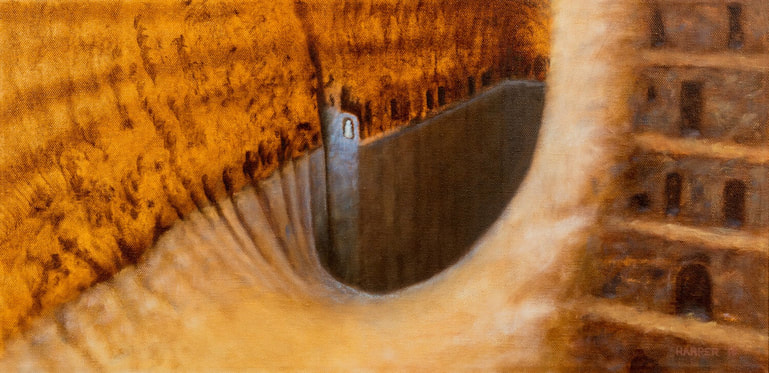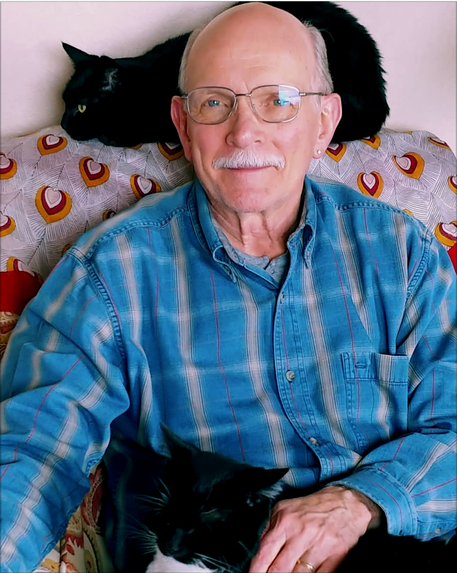A B O U T
THE ARTIST'S JOURNEY
RICHARD HARPER
ARTIST’S STATEMENT
ARTIST’S STATEMENT
As long as I can remember, I have been intrigued by seed pods and the way things in nature explode into being, often quietly and unseen. The entire life cycle interests me: birth, life, death, and rebirth. This theme continues to inform and appear in my paintings.
When I was a college student, Otis O. Lumpkin, a master painter and educator, introduced me to oil painting. Naturally, I wanted to paint like Otis, so my early paintings were representational with a touch of the surreal and the artist’s personal memory and experiences. My very first painting was a still life, which included a white sphere located close to the center of the composition. After that, I began to paint imaginary settings and compositions -- people and objects in uncommon or unusual settings and surroundings -- painting what I imagined rather than what I actually observed with my eyes. During those early years, the painters I was drawn to included Otis Lumpkin, Andrew Wyeth, and Salvador Dali. I have since added George Inness, especially his work in later years, and Martin Johnson Heade, a Luminist of the nineteenth century. Of course, I love the works and lives of many other artists, however, I most often revisit the work of Wyeth, Inness, and Heade.
Today, although it matters to me that the finished painting is well executed and presented, I am even more interested in what happens during the creative process itself. Although my early education was studying the “old master” technique where the drawing is of extreme importance, I now often begin paintings with a very loose sketch, or no sketch at all. I paint intuitively, influenced by circumstances and events that move me. I try to “trust the process,” and ask that I be granted the openness and courage to paint what I am led to paint rather than what I “think” will be pleasing. I seek to paint what I have known before -- perhaps in another life but have since forgotten -- or what I have never known, but am now shown. It is my hope that my work touches the viewer in a visceral way; in some way or place that the viewer may not understand or articulate. I hope the viewer will be attracted by the strength of the composition and held there long enough to see and explore the total environment of the work.
I have often been asked about the ubiquitous sphere that appears in most of my compositions. Traditionally, the sphere represents perfection or beauty. In my work I often see it as a character in the scene, as in a novel or a play; a silent observer - off to the side, or the center of attention - around which everything else revolves. I do not know exactly what it means or stands for; however, I have considered it enough to formulate a theory: I believe that sometimes the sphere represents myself; quite often my higher self, or a higher set of principles that we (humanity as a whole) or I (as an individual) might have chosen in the past or might choose going forward.
When I was a college student, Otis O. Lumpkin, a master painter and educator, introduced me to oil painting. Naturally, I wanted to paint like Otis, so my early paintings were representational with a touch of the surreal and the artist’s personal memory and experiences. My very first painting was a still life, which included a white sphere located close to the center of the composition. After that, I began to paint imaginary settings and compositions -- people and objects in uncommon or unusual settings and surroundings -- painting what I imagined rather than what I actually observed with my eyes. During those early years, the painters I was drawn to included Otis Lumpkin, Andrew Wyeth, and Salvador Dali. I have since added George Inness, especially his work in later years, and Martin Johnson Heade, a Luminist of the nineteenth century. Of course, I love the works and lives of many other artists, however, I most often revisit the work of Wyeth, Inness, and Heade.
Today, although it matters to me that the finished painting is well executed and presented, I am even more interested in what happens during the creative process itself. Although my early education was studying the “old master” technique where the drawing is of extreme importance, I now often begin paintings with a very loose sketch, or no sketch at all. I paint intuitively, influenced by circumstances and events that move me. I try to “trust the process,” and ask that I be granted the openness and courage to paint what I am led to paint rather than what I “think” will be pleasing. I seek to paint what I have known before -- perhaps in another life but have since forgotten -- or what I have never known, but am now shown. It is my hope that my work touches the viewer in a visceral way; in some way or place that the viewer may not understand or articulate. I hope the viewer will be attracted by the strength of the composition and held there long enough to see and explore the total environment of the work.
I have often been asked about the ubiquitous sphere that appears in most of my compositions. Traditionally, the sphere represents perfection or beauty. In my work I often see it as a character in the scene, as in a novel or a play; a silent observer - off to the side, or the center of attention - around which everything else revolves. I do not know exactly what it means or stands for; however, I have considered it enough to formulate a theory: I believe that sometimes the sphere represents myself; quite often my higher self, or a higher set of principles that we (humanity as a whole) or I (as an individual) might have chosen in the past or might choose going forward.

